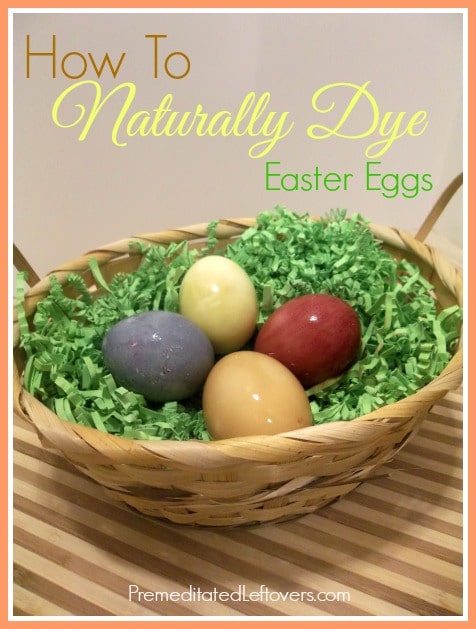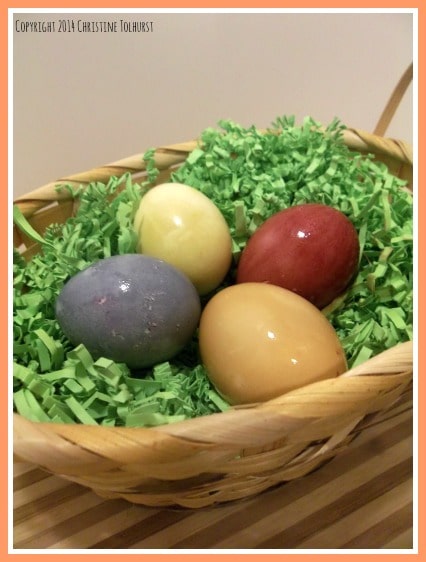
Easter is almost here and I was really excited to try to dye eggs with natural plant based dyes this year. I was nervous to try as I had never done this sort of egg dying before, but naturally dying Easter eggs is actually quite simple and requires no special skills. For me, that’s good news since I am not all that crafty.
There are many ways you can dye the eggs naturally, depending on the colors you are trying to achieve, but I took the fastest way. For instance, the get a lavender color, you can make your own reduction of boiled red cabbage and dip your eggs in that, but that was just too time consuming for me to do this time around.
All of the ingredients used in these natural dying processes were bought from a regular natural foods store, so there was no need to search them out. I think I paid around $15 for all the supplies, including the eggs, and some I had on hand.
How To Dye Easter Eggs Naturally
The main element you will need to do this craft is eggs. I suggest using eggs that are not fresh. Of course, you don’t want spoiled eggs, but eggs that are around 3-4 days old are perfect. The reason for this is when you go to peel them, the membrane will separate easier, making it easier to peel.
Also, you will want to use glass containers to place the dye in so they do not stain.
Supplies:
- Distilled White Vinegar
- Hard boiled eggs, cooled
- Very strong coffee (For Brown/Caramel color)
- 100% Beet Juice (For Pink/Maroon)
- 100% Blueberry Juice (For Lavender/Light Blue)
- Ground Turmeric (For Gold/Yellow)
- Water
Directions:
1. Start by laying down newspaper on your working surface. This project gets very messy, very easily and can stain porous surfaces.
2. Separate your eggs into containers. Ideally, you will want them to be in a single layer so they are not touching each other as you will have spots that don’t get dyed if that happens. Also, your containers should not be too shallow or the dye will not cover the eggs fully.
3. To make turmeric Dye, add 4 heaping tablespoons of turmeric to a bowl. Add 2 1/2 cups water to it and using a whisk, mix until there are no lumps. Add 2 1/2 tablespoons vinegar and mix. Pour the mixture over the eggs you want to dye yellow. The dye should completely cover them.
4. To make your coffee dye, add 3 cups coffee to 3 tablespoons vinegar. Mix well and pour over eggs in the container you want to dye brown.
5. To make blueberry dye, add 2 cups blueberry juice to 2 tablespoons vinegar. Pour it over the eggs you want to dye lavender.
6. To make beet juice dye, add 2 cups beet juice to 1/2 cup water. Add in 2 1/2 tablespoons vinegar. Mix well and pour over eggs you want to dye maroon.
7. Depending on how deep and vibrant you want your colors, you will leave the eggs in the dye for varying lengths of time. For pastel colors, 1-2 hours will do. For deep colors, like the ones I did, leave them in the dye for 6-7 hours.
8. Be careful when you remove them as the dye will stain. Use a spoon to carefully get them out of the glass containers and use care when draining off the dye. Allow to air dry and if you like them to be shiny, use a little bit of olive oil on a soft cloth to polish them.
Have you ever dyed Easter eggs naturally? What technique did you use and how did they turn out? Are you going to try to dye your Easter eggs naturally this year? I would love to hear about it in the comments!



Tanja says
Dying Easter eggs by cooking them in onion skins is an old custom in Serbia. But, there is a way to make them even prettier: pick different small leaves, blades of grass etc. Take some old (or cheap new) nylon stockings and cut them in squares (3,5×3,5”). Put a leaf or a combination of grass blades on the egg, then carefully “pack” it in the nylon square; pull the four angles together and tie with a piece of string. Put them on the onion skins and add cold water. Let boil (slow!) and leave them to cook cca 30 minutes. Unpack while hot (so that greenery don’t stick to the shell). Let dry. If you want them shiny, use a cotton ball soaked with few drops of olive or sunflower oil.
Works like a charm every time!
Besides being very pretty, eggs cooked “packed” like this almost never crack…
d. copley says
Every year I have dyed eggs the natural way. I put red or yellow onion skins in the water
With the eggs and add some vinager. Boil until eggs are cooked. The longer you leave skins
The darker the color.
Farm Fresh Mama says
I love this! Thank you so much for sharing a natural alternative!